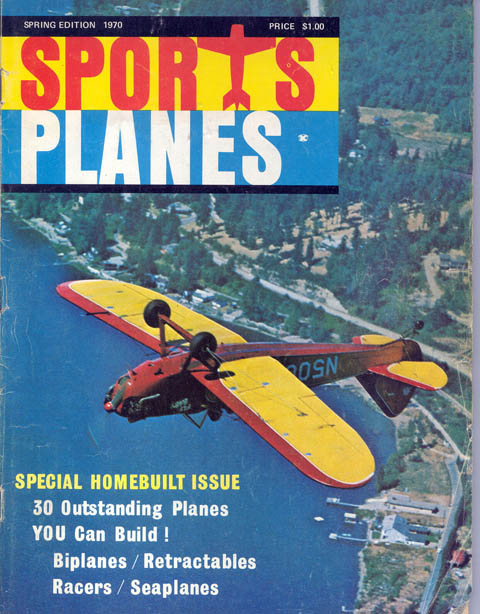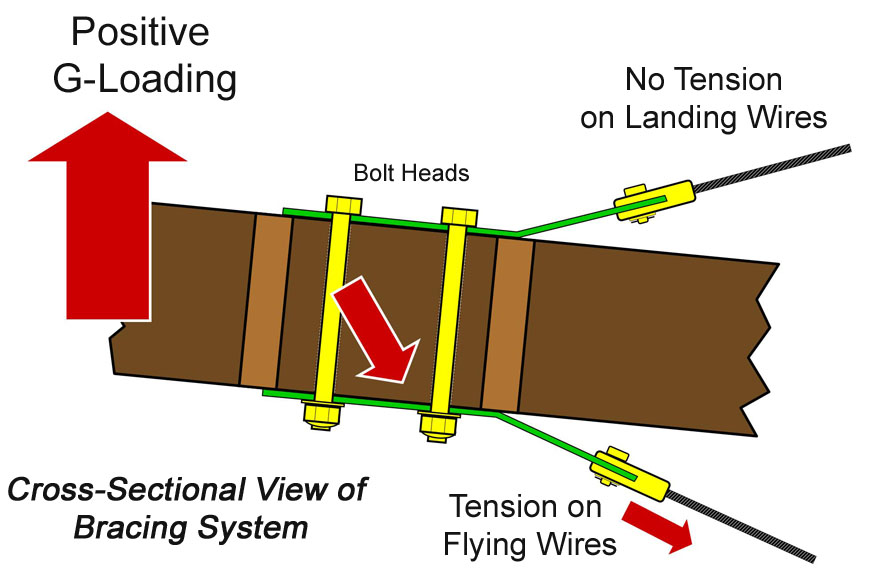Aerobatics
and Fly Babies: An Editorial
By Ron Wanttaja
22 June 2008
The following contains myown
opinions; I do not speak for the Bowers estate. While
I am an engineer, I am an electrical engineer, with no training in
aeronautical engineering. Nor, for that matter, am I any
sort of expert in flying aerobatics.
When you look at the accident reports, one
thing really stands out: The Fly Baby has suffered from a fairly
high rate of wing
failure: Thirteen out of about 51 accidents involved failure of
the wings or bracing system.
Of that...nearly half (six) involved aircraft doing aerobatics.
 Pete was OK with
aerobatics in the Fly Baby, performing them himself and writing about
it in SPORT PILOT and other magazines (including this cover shot from
SPORT PLANES).
Pete was OK with
aerobatics in the Fly Baby, performing them himself and writing about
it in SPORT PILOT and other magazines (including this cover shot from
SPORT PLANES).
Any plane can do aerobatics...just ask
Bob Hoover! But when you consider that over 10% of the total Fly
Baby accidents involved wing failures in aerobatics, it's time to
reconsider.
What sort of structural strength is required for aerobatic
airplanes? If the plane is a homebuilt, none. There are no
regulatory restrictions on flying aerobatics in a homebuilt
airplane...they aren't required to meet the same requirements as
production aerobatics airplanes like Decathlons.
"Yes, but...they successfully tested that Fly Baby to +6Gs/-3Gs in Finland in 1977! Doesn't
that prove the Fly Baby meets the same structural requirements as
certified aerobatic airplanes?"
Well, no. 14CFR Part 23 does say that an aerobatic airplane must
be capable of withstanding flight loads of +6 Gs and -3 Gs without
permanent deformation, and that's what the Finnish Fly Baby was tested
to.
However, Part 23 requires a 1.5x Margin
of Safety. This means that to qualify for aerobatic
certification, the airplane must be shown to be able to support 9Gs for at least three seconds
(and, of course 4.5Gs negative).
The only real way to prove this is to test an airframe to destruction,
and the tests in Finland were to allow certification of the plane under
test that the owner planned to fly. They weren't going to keep
piling on the sandbags until it broke!
For all we know, Fly Baby OX-XOS's wing would have failed at
6.1Gs. So the only thing we can logically do is extract the
margin of safety from the values it was tested to... +6Gs / 1.5 =
+4Gs, -3Gs / 1.5 = -2Gs.
Which is just about midway between Normal and Utility categories.
There's also another factor to consider. The classic General
Aviation aerobatics airplanes have been biplanes. It's easy to
attain significant structural strength in a wire-braced biplane, as the
Landing and Flying bracing wires form an "X", and the cables can be
tightened to a high degree of tension to minimize the fatigue effects
on the metal fittings and the cables themselves.
However, monoplane
Fly Babies can't do this. Tightening the Landing or Flying wires
draws the wing tighter to the fuselage. If you tighten the Flying
wires on the right wing, the Landing wire on top does get somewhat
tighter, but there isn't the mechanical advantage the biplane
has.
 Fly Baby pilots are
accustomed to seeing the landing wires sag a bit
during flight. This is nothing to be concerned about...it's
common, and doesn't harm anything during normal flight, or even when
you pull a few Gs
Fly Baby pilots are
accustomed to seeing the landing wires sag a bit
during flight. This is nothing to be concerned about...it's
common, and doesn't harm anything during normal flight, or even when
you pull a few Gs
However, if one were pulling several positive Gs in a
Fly Baby, then suddenly "pushed over" into a negative-G maneuver, the
wing will jerk downward as that slack in the Landing Wires comes out.
This is certainly not
ideal; the abrupt stop will cause a momentary spike in the stress in
the bracing system. Imagine you need a short piece of string but
don't have a knife or scissors to cut one off from the spool.
What do you do? You could just slowly pull on the string until it
breaks, but most of us would just wrap a bit around our hands and jerk
suddenly. It's the same thing with the Fly Baby...you should try
to avoid sudden transitions between high positive and negative
G-loading conditions.
My own Fly Baby's operating limitations prohibit aerobatics.
I've
been told that due to some of Fly Baby wing failures in the '70s, the
FAA had been prohibiting aerobatics for planes finished in the early
'80s (Like mine
was). However, I have found no evidence of this. However, if you
look though the accident reports, comments were made in at least one
case that aerobatics were not approved for that particular airplane.
Allow me to emphasize my own opinion: A Fly Baby is NOT a
Pitts Special. It's not a Great Lakes. It's not
Acroduster. It's a fun little plane for zipping around in on nice
days, but it not really meant for serious aerobatics. If you
would still like to do a few
casual loops and rolls in your Fly
Baby, upgrade the wing anchor bolts like Pete says, and avoid any
maneuver that features a rapid transition between positive and negative
Gs.
Ron Wanttaja.
Alternate Views
I often receive email on these types of subjects. Since I'm not
an expert on structural issues, I prefer to post the messages that
differ with my own conclusions....
Comment:
One
thought about the negative "G" theory you mentioned. If these
planes are so delicate, that going from a positive to negative G can
pop the wings off, we probably shouldn't be flying them. You
would think more wings would fail during turbulence and hard landings,
where the G forces change instantaneously.
Response:
I don't mean to imply that the plane can't handle a transition between
one positive G and one negative G. After all, this web page
begins with a picture of N500F in inverted flight! I think the
problem might occur when a plane is pulling several positive Gs, and a
sudden pushover to negative Gs is made. Or even to several Gs in
the negative direction. I've edited the above text to make that
clearer.
Ron
 Pete was OK with
aerobatics in the Fly Baby, performing them himself and writing about
it in SPORT PILOT and other magazines (including this cover shot from
SPORT PLANES).
Pete was OK with
aerobatics in the Fly Baby, performing them himself and writing about
it in SPORT PILOT and other magazines (including this cover shot from
SPORT PLANES). Fly Baby pilots are
accustomed to seeing the landing wires sag a bit
during flight. This is nothing to be concerned about...it's
common, and doesn't harm anything during normal flight, or even when
you pull a few Gs
Fly Baby pilots are
accustomed to seeing the landing wires sag a bit
during flight. This is nothing to be concerned about...it's
common, and doesn't harm anything during normal flight, or even when
you pull a few Gs